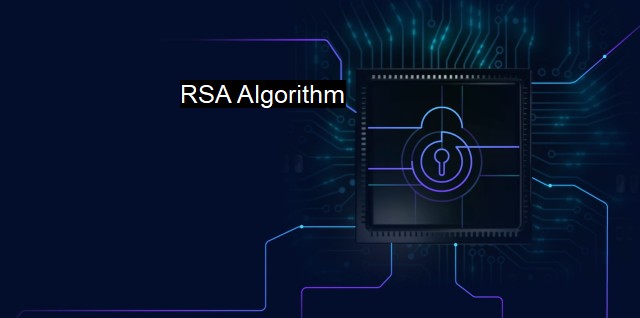What is RSA Algorithm?
The Significance of RSA Algorithm in Cybersecurity: Safeguarding Sensitive Data through Public Key Cryptography
The RSA Algorithm, an acronym derived from the names of its inventors - Ron Rivest, Adi Shamir, and Leonard Adleman, is a significant encryption protocol underpinning many modern cybersecurity and antivirus systems. Developed in 1977, it belongs to the family of public key cryptosystems and operates through factorizing extremely large numbers into two prime numbers, to generate encryption and decryption keys that sustain secure communications and data exchanges.The RSA encryption algorithm plays a prominent role in ensuring the privacy, integrity, and authenticity of digital content. The method fundamentally rests on the practical difficulty related to factoring large integers, a standard that makes RSA propitious for secure data transmission when the keys are adequately long.
The intricacies and utilization of RSA enfold within two overarching procedures: key generation process and the detailed encryption and decryption process. For the former, RSA operates with prime numbers which are randomly generated. The prime numbers chosen have to be substantially large, usually 100 or more digits, to ensure the security level. After this, values are calculated to obtain encryption and decryption keys concurrently.
The second phase involves encryption and decryption. When a sender wishes to share encrypted information, they utilize the receiver’s public key to convert plaintext to an incomprehensible cipher text. Only the authorized recipient with the relevant private key can decrypt and revert the data back into its original form.
In antivirus applications, RSA encryption is often deployed. Given the rising threats of cybercrimes, protecting vulnerable user-information is vital. Consequently, many cybersecurity firms integrate RSA encryptions in their antivirus software so when users opt to execute cloud backups of essential data, the RSA-algorithm-encrypted transmission ensures data's privacy and integrity.
The RSA Algorithm plays a pioneering role in forming a foundation for the secure sockets layer (SSL) and transport layer security (TLS) protocols. These protocols are crucial to providing contemporary web security, with RSA public key encryption ensuring transmitted data remains confidential and verifies the server’s identity. Consequently, every communication accomplished across a potentially insecure platform is therefore encrypted and verified via the RSA algorithm.
The strength of RSA tends to weaken with shorter encryption key lengths putting the data at risk due to the emergence of increased processing power leading to quicker prime factorization of the larger integer. advancements in technologies such as quantum computing may pose legitimate threats to RSA security in the future.
The RSA is a powerful algorithm heavily relied on in our day-to-day digital activities. Much of our current cybersecurity architecture is structured around it in different ways to ensure safe and secure communication, leading us to infer the immense importance of this revolutionary cryptosystem.
Ensuring robust protection of our network systems needs the ongoing development of encryption processes. Future advancement in cyber threats cannot be dismissed or neglected. Thus, practices like enhancing key lengths, preventing unauthorized key exposure, and consistently updating cryptographic tools become essential for the sustenance of RSA algorithm’s security that propels cybersecurity and antivirus functions, maintaining our digital environments securely.
In the end, the RSA algorithm serves as one cryptographic approach amongst many others, nonetheless, it remains a cornerstone that encapsulates the principles of encryption and cybersecurity, whose role in combating cyber threats and ensuring data protection is paramount.

RSA Algorithm FAQs
What is the RSA algorithm?
The RSA algorithm is a popular public-key encryption method used to secure data transmission over the internet. It is named after its inventors, Ron Rivest, Adi Shamir, and Leonard Adleman.How does the RSA algorithm work?
The RSA algorithm uses two keys - a public key and a private key - to encrypt and decrypt data. The public key is used to encrypt the data and can be shared with anyone, while the private key is kept secret and used to decrypt the data. The security of the algorithm lies in the fact that it is computationally infeasible to determine the private key from the public key.Is the RSA algorithm secure?
The RSA algorithm is considered to be secure, provided that sufficiently long keys are used. The security of the algorithm relies on the difficulty of factoring large prime numbers, which is believed to be computationally infeasible. However, with advances in computing power, it is possible that the RSA algorithm may be vulnerable to attacks in the future.How is the RSA algorithm used in cybersecurity and antivirus products?
The RSA algorithm is used in various cybersecurity and antivirus products to encrypt and decrypt sensitive data, such as passwords, credit card information, and other personal data. It is also used in digital signature schemes to verify the authenticity and integrity of data. Many antivirus products use the RSA algorithm to encrypt their virus signatures and prevent them from being tampered with.| | A | | | B | | | C | | | D | | | E | | | F | | | G | | | H | | | I | | | J | | | K | | | L | | | M | |
| | N | | | O | | | P | | | Q | | | R | | | S | | | T | | | U | | | V | | | W | | | X | | | Y | | | Z | |
| | 1 | | | 2 | | | 3 | | | 4 | | | 7 | | | 8 | | |||||||